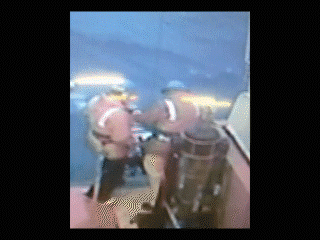Particle Pat the Pump Master, Part 2
Today, we return to Particle Pat’s heroic adventures in particle pumping. When we last left Pat, he was extremely soggy, somewhat foggy, and rather groggy. Long hours of particle pumping at odd hours will do that to you, especially when this happens…
…Well, you’ll have to read all the way to the end of this post about the intricacies of particle pumping to find out the extent of Pat’s heroism, but it will be well worth it, I promise.
Despite the manifold perils of particle pumping, Particle Pat is back today and pumping marine snow out of the Southern Ocean with a vengeance.
We’re out on the aft deck this morning—regulation floatation jackets, hard hats, and steel-toed boots on—ready to lend a hand as the pumps return to the surface. As usual, Pat and marine technician Joee are clipped in to their safety lines as they wait for the winch to gently haul the four McLane pumps, which have been happily pumping deep in the sea since 5:30 this morning, back to the surface.
The pumps return at intervals, as they have been clamped to different points on the cable and have, therefore, been at different depths in the sea: 25 m, 50 m, 250 m, and 800 m. This allows collection of material from the zones where diatoms live and thrive (25 m and especially 50 m—the “chlorophyll maximum”), and from deeper in the sea where deceased diatoms are sinking toward the seafloor. As we’ve discussed, many of these dearly departed diatoms will be eaten or dissolve during the downward journey, and many of those eaten will be delivered to the seafloor in fecal pellets. And some will complete their voyage intact to be incorporated into the oozy diatomaceous mud that coats many parts of the seafloor and which provides a history of diatoms—and climate—long past.

As each pump nears the surface, marine technician Joe communicates with the winch operator in the aft control room via a series of hand signals.
After all four pumps are safely back on deck and inside, we first record data from the flowmeter and determine how well each pump has functioned, how much water it has filtered, and for how long. Pat removes the section of each pump containing the filters and takes it to the aft dry lab for processing.
(Meanwhile, the megacorer is about to be deployed. While we filter particles, we’ll be monitoring its progress toward the seafloor and back via the screen in the aft dry lab. There’s always something going on while we’re at a sampling station, and it’s a fine balancing act to coordinate all that must be done.)

As we learned in Part 1, we’re using two filters in these pumps. Wearing gloves and using forceps sterilized with ethanol, Pat removes each filter and rinses it with filtered seawater. This seawater was retrieved in the very early morning, not long after we arrived at this station and after the survey process was complete, when we sent down the CTD. It comes from deep in the ocean where there are fewer particles, and then the rest of the particles are removed during filtration—it is as clean of particles as we can get it. The filters then go into a sonic bath for five minutes; it shakes any remaining particles free from the filter screen.

The golden-brown color of diatoms is clearly visible on this screen from 50 meters down—the “chlorophyll maximum.”
He ends up with a soup of filtered seawater and recovered particles, most of which will be diatoms. It’s interesting to see the difference between the filters from deep in the ocean, where there is less marine snow (because so much is eaten and recycled by organisms on its downward journey) and that from those taken from the 50-meter-deep pump, right in the “chlorophyll maximum” (the area of greatest diatom abundance).

Before dividing it up for the team, Becky homogenizes the water so it is evenly mixed. Particle Pat, wearing his high-powered diatom detector, studies the sonic bath.
Becky divides the particle soup (which just looks like clear water) for use by the team. Mark’s team will test their portion for biogenic silica; this gives us a rough idea of what proportion of the particles are diatoms. Christina, our diatom taxonomist, will look at the diatom assemblage and determine exactly which species are present.
Becky’s team uses 20% of their portion to filter out for measurement of total organic carbon and nitrogen and the isotopic composition of the nitrogen. The rest is filtered to isolate just the diatoms. Different screens are used for these purposes. A glass filter screens out the organic compounds, and a polycarbonate plastic screen the diatoms. We can’t use a glass screen for the diatoms because, since diatom frustules (skeletons) are made of glass, and this might give us an inaccurate view of how much biogenic silica is present and more likely, contaminate the silicon isotope signal.

A polycarbonate filter, thick with diatoms, ready to be frozen and transported back to Rhode Island.
The organic compound filter is folded up in a piece of aluminum foil, which has been sterilized at high temperatures in a combustion oven. The filters with diatoms are placed in a test tube and frozen for transport back to Rhode Island for analysis.
This process is repeated for each of the eight filters (two filters in each of the four pumps), and each sample is labeled so we know which filter and depth it came from and when.
So, there you have it, the entire Particle Pumping Process… You made it, and now you’re ready for the best part!
























